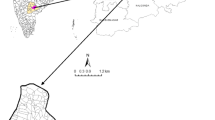Abstract
This study aims to compute the potential runoff in the mountain Wadi Ḑamâd watershed located in the South Western of Saudi Arabia, using Soil Conservation Service-Curve Number (SCS-CN) method based on the maximum daily rainfall recorded during 47 years from 1970 to 2016 at the stations of Ḑamâd, Ayban, Wadi Ḑamâd and Jabal Fayfa, Malaki, and Al Aridhah. The SCS-CN method depends on land use, land cover, and soil complex characteristics of a watershed, and it is the hydrological model widely used for estimating runoff using curve number (CN). In the present study, SCS-CN method is used for estimating the potential runoff in the mountain drainage basin of Wadi Ḑamâd extends on area of 1084.0 km2. The CN was obtained at every studied station using the sheet 78 of the land resources map 1:500,000, and it is 62 at Ḑamâd, 66 at Ayban and Jabal Fayfa, and 70 at Wadi Ḑamâd, Malaki, and Al Aridhah. The potential maximum retention corresponding to these CN was 141.2 mm, 117.2 mm, and 108.9 mm. Therefore, the initial abstraction corresponding to the potential maximum retention is respectively 28.2 mm, 23.4 mm, 21.8 mm, and 23.4 mm. The results of this study reveal that the average of yearly rainfall varies from 171.3 to 538.1 mm, and the maximum daily rainfall is ranged between 37.4 and 77.5 mm at Malaki and Ḑamâd respectively. In the opposite, the excess rainfall and the direct runoff vary systematically with the rainfall. The maximum excess rainfall is ranged between 60.6 mm at Jabal Fayfa and 103.2 mm at Wadi Ḑamâd. However, the direct maximum runoff rises respectively from 20.6 to 50.2 mm.












Similar content being viewed by others
References
Arnold JG, Williams JR, Srinivasan R, King KW (1996) SWAT: Soil and Water Assessment Tool. Grassland, Soil & Water Research Laboratory, U.S. Department of Agriculture, Temple
Beven KJ (2012) Rainfall-runoff modeling: the primer, 2nd edn. Wiley-Blackwell, Hoboken
Dhawale AW (2013) Runoff estimation for Darewadi watershed using RS and GIS. Int J Recent Technol Eng 1(6):46–50
Hawkins RH (1993) Asymptotic determination of runoff curve numbers from data. J Irrig Drain Eng 119:334–345. https://doi.org/10.1061/(ASCE)0733-9437(1993)119:2(334)
Kothyari UC, Jain SK (1997) Sediment yield estimation using GIS. Hydrol Sci J 42(6):833–843
Michel C, Andréassian V, Perrin C (2005) Soil Conservation Service Curve Number method: how to mend a wrong soil moisture accounting procedure? Water Resour Res 41:W02011. https://doi.org/10.1029/2004WR003191
Mishra SK, Singh VP (2003) Soil Conservation Service Curve Number methodology. Water Sci Technol Lib, Springer, New York
Pechlivanidis IG, Jackson BM, McIntyre NR, Wheater HS (2011) Catchment scale hydrological modeling: a review of model types, calibration approaches and uncertainty analysis methods in the context of recent developments in technology and applications. Glob NEST J 13(3):193–214
Ponce VM, Hawkins RH (1996) Runoff curve number: has it reached maturity? J Hydrol Eng ASCE 1:11–18
SGS (2017) Kingdom of Saudi Arabia: facts and figures (in Arabic). Saudi Geological Survey, Jeddah
Soil Conservation Service (2004) National engineering handbook, section 4: hydrology. Soil Conservation Service, USDA, Washington, D.C.
Soulis KX, Valiantzas JD (2012) SCS-CN parameter determination using rainfall-runoff data in heterogeneous watersheds - the two-CN system approach. Hydrol Earth Syst Sci 16:1001–1015. https://doi.org/10.5194/hess-16-1001
Tejaswini NB, Shetty A, Hedge VS (2011) Land use scenario analysis and prediction of runoff using SCSCN method: a case study from the Gudguji Tank, Haveri District, Karnataka, India. Int J Earth Sci Eng 4(5):845–853
Williams JR (1995) The EPIC model. In: Singh VP (ed) Computer models of watershed hydrology. Water Resources Publications, Littleton
Wu TH, Hall JA, Bonta JV (1993) Evaluation of runoff and erosion models. J Irrig Drain Eng 119(2):364–382
Xu CY (2002) Hydrologic models, vol 2. Uppsala University Department of Earth Sciences Hydrology, Uppsala
Xu AL (2006) A new curve number calculation approach using GIS technology. ESRI 26th International User Conference on Water Resources
Young RA, Onstad CA, Bosch DD, Anderson WP (1987) AGNPS, agricultural non-point source pollution model: a watershed analysis tool. USDA-ARS, Washington, D.C.
Zhang Y, Chiew F (2009) Relative merits of different methods for runoff predictions in un-gauged catchments. Water Resour Res 45(7):W07412. https://doi.org/10.1029/2008WR007504
Author information
Authors and Affiliations
Corresponding author
Additional information
Responsible Editor: Broder J. Merkel
Rights and permissions
About this article
Cite this article
Alhumimidi, M.S. Estimation of potential runoff in Wadi Damad watershed, Jazan Province, southwestern Saudi Arabia. Arab J Geosci 13, 296 (2020). https://doi.org/10.1007/s12517-020-5267-2
Received:
Accepted:
Published:
DOI: https://doi.org/10.1007/s12517-020-5267-2




